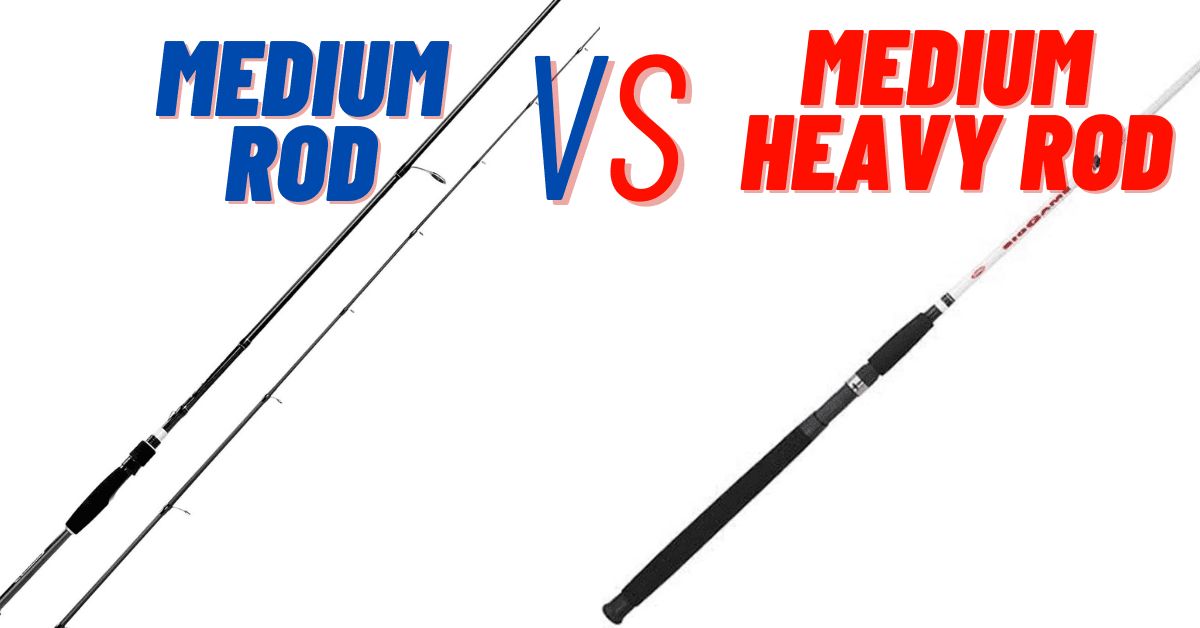Medium vs Medium Heavy Rod: What is The Difference?
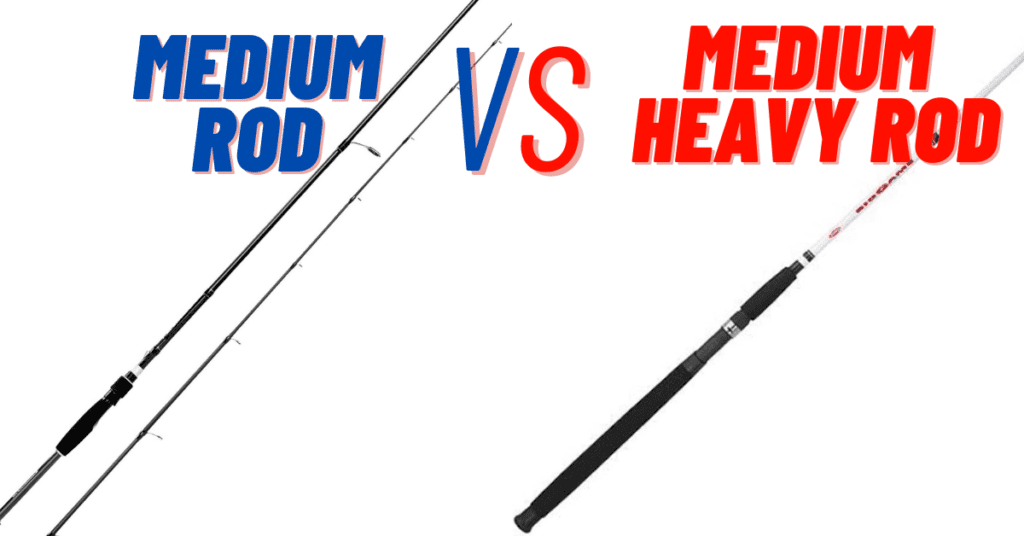
When it comes to fishing, the fishing rod is one of the most important tools in your arsenal. But with so many different types of rods available, it can be difficult to know which one to choose.
One of the most common debates among anglers is medium vs medium-heavy rod. The decision between these two options can greatly impact your fishing performance.
In this article, I will walk you through the differences between medium and medium-heavy rods, and their applications, and help you make an informed decision based on your specific fishing needs.
Understanding Fishing Rods
When I first started fishing, I didn’t know much about the different parts of a fishing rod or what they did. However, after some research, I found out that every fishing rod is made up of a few main parts: the handle, reel seat, guides, and blank.
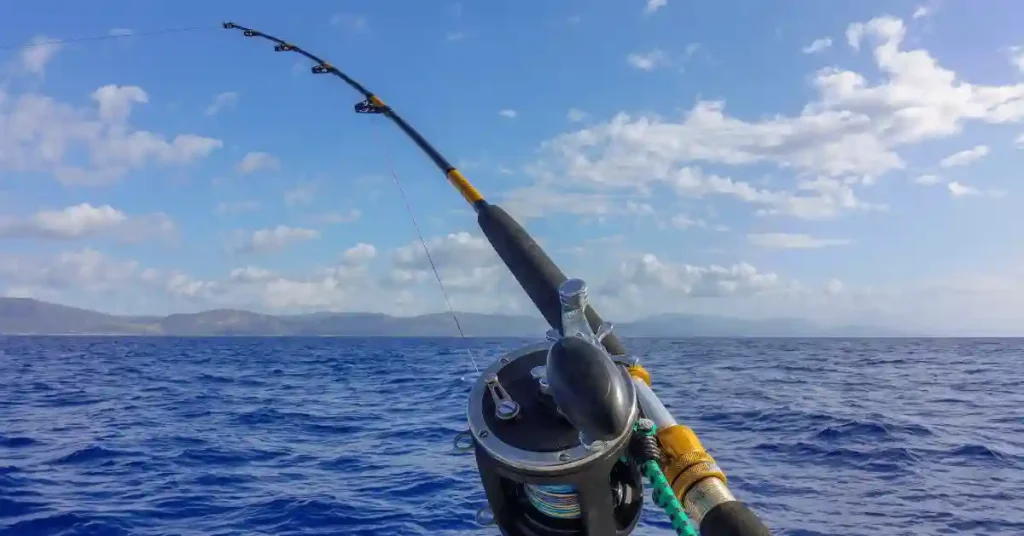
The blank is like the main body of the rod, and it determines a lot about how the rod works. The handle is where you hold the rod, and the reel seat is where you attach your fishing reel. The guides are the little rings along the rod that help guide your fishing line.
Knowing about these parts is important when you’re choosing a fishing rod. The blank, especially, affects how strong and flexible the rod is. Rod power is about how well the rod can handle heavy stuff, like big fish or heavy lures.
Rod action is about how much the rod bends when you put pressure on the tip.
The power of a rod comes from its blank, and heavier blanks mean the rod has more power. So, if you’re going after big fish or using heavy lures, you’ll want a rod with a higher power rating.
But if you’re fishing for smaller fish or using lighter lures, a rod with a lower power rating should be fine.
Medium Rods: Versatility and Finesse
Medium rods are great all-rounders for fishing. They work well in many situations and are often recommended for beginners because they’re forgiving and easier to handle than heavier rods. These rods are best for casting small, lightweight lures and soft plastics with precision.
One of the best things about medium rods is how sensitive they are. Their tip bends just enough to detect even the tiniest bites from fish, which is super important for delicate fishing techniques.
Medium rods also give you good control when casting. They’re flexible enough for long casts, especially if you’re using light lures. You can cast weights from 1/8 ounce spoons to 1/2 ounce crankbaits easily with them.
In terms of strength, medium rods are sturdy enough for medium-sized fish, but they might struggle with bigger, more aggressive ones. So, if you’re after really big fish, you might want to consider a heavier rod.
Medium Heavy Rods: Power and Force
Medium-heavy rods are all about power. They’re made for handling heavier lures and tougher fishing situations. These rods have a strong backbone, which gives you more strength when setting the hook and reeling in big, fighting fish.
While they might not be as sensitive as medium rods, medium-heavy rods are perfect for catching larger fish like catfish, salmon, musky, or big bass. They’re built to handle the force of these hard fighters.
When it comes to luring weight, medium-heavy rods are best suited for heavier baits, usually over 1/2 ounce. They can handle lighter lures too, but their stiffness might make it harder to cast them accurately.
In terms of casting, medium-heavy rods might not be as flexible as medium rods, so you might not get the same distance. But they’re great for casting heavier lures.
If you’re okay with sacrificing a bit of distance for the ability to cast larger baits, then a medium-heavy rod could be the right choice for you.
Medium vs Medium Heavy Rod – The Comparison
When you’re deciding between a medium and medium-heavy fishing rod, think about what you need. I like a medium-heavy rod because I fish in saltwater for big fish. But if you’re new to fishing or mostly fish in freshwater or shallow saltwater, a medium rod might be better.
The main difference between these rods is how strong they are. A medium rod usually handles 6-12 pounds, while a medium-heavy rod can handle 10-20 pounds.
Medium rods are good for smaller fish and lighter lures, while medium-heavy rods are for bigger fish and heavier lures.
Another difference is how fast they cast. Medium rods cast slower, which is good for accurate casts or fishing in small areas. Medium-heavy rods cast faster, so you can cast farther and reach fish that are farther away.
When you’re picking between these rods, think about the size of the fish you’ll be going after, the weight of the lures you’ll be using, and where you’ll be fishing. Considering these things will help you choose the right rod for you.
Medium Rod
Pros:
- Versatile for various fishing techniques.
- Offers a good balance of sensitivity and power.
- Ideal for lighter lures and lines.
- Great for finesse fishing.
- Easier to cast with lighter baits.
Cons:
- Limited for handling heavier fish.
- Less effective for heavy cover fishing.
- Not optimal for deep water fishing.
- May lack the backbone for pulling in larger fish.
- Can be less accurate for long-distance casting with heavy lures.
Medium-Heavy Rod
Pros:
- Provides more power for handling bigger fish.
- Ideal for fishing in heavy cover.
- Offers greater sensitivity than heavier rods.
- Suitable for a wide range of fishing techniques.
- Provides better hook-setting capabilities.
Cons:
- Less sensitive compared to lighter rods.
- Might be too stiff for finesse fishing.
- Can cause fatigue during long casting sessions.
- Less suitable for light lures and lines.
- Not as accurate for short-distance casting finesse presentations.
What does rod power mean?
In the beginning, the term “rod power” was a bit confusing to me among all the other fishing rod jargon. But now I get it – rod power means how well a rod can handle heavy stuff, like big fish or hefty lures. It’s all about the rod’s strength.
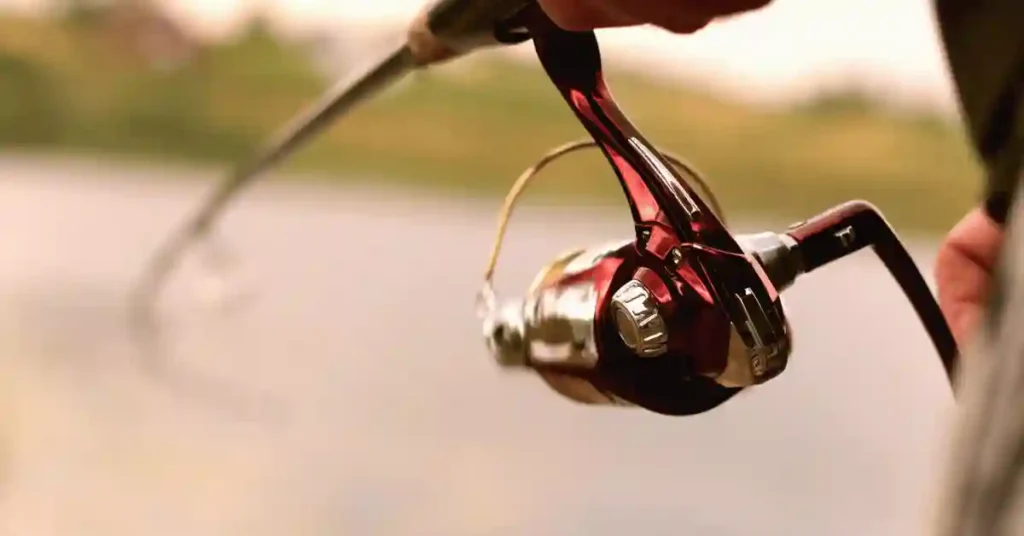
When you’re looking for a fishing rod, keep an eye on its power rating. Rods usually fall into one of seven power categories: ultra-light, light, medium-light, medium, medium-heavy, heavy, or extra-heavy.
A higher power rating means the rod can handle more weight. For instance, a medium-heavy rod can handle heavier lures and fish compared to a medium rod.
The power of a rod comes from its blank, which is the main part of the rod. How heavy and stiff the blank is determines the rod’s power rating. Heavier and stiffer blanks mean a higher power rating, while lighter and more flexible ones mean a lower power rating.
So, if you’re going after big fish or using heavy lures, go for a rod with a higher power rating. But if you’re fishing for smaller fish or using lighter lures, a rod with a lower power rating should do the trick.
Rod power’s effect on casting
The power rating of your fishing rod can affect how well you cast. With a medium rod, your casting speed is usually slower. This is good for making accurate casts, especially in smaller bodies of water.
On the flip side, a medium-heavy rod casts faster. This is handy when you need to cast farther, like in bigger bodies of water.
I like using a medium-heavy rod for casting because it gives me more power and speed. I can cover more ground and reach fish that are farther away.
But if you’re new to fishing or fishing in a smaller area, a medium rod might be better. It gives you more control over your cast and lets you be more accurate.
Ultimately, when it comes to casting, go with a rod that feels right for you. Try different rods to see which one feels the most comfortable in your hands. This will give you the best chance of casting well when you’re out fishing.
Rod Power’s effect on hooksets
In fishing, setting the hook is crucial for reeling in your catch. The power of your rod can affect how well you set the hook. With a medium rod, there’s more flexibility when you set the hook, which is good for smaller fish.
But with a medium-heavy rod, it’s stiffer and more responsive, making it great for bigger fish or when you need to set the hook fast.
I’ve found that with a medium-heavy rod, I can set the hook firmly even with big fish. The stiffness helps me set the hook quickly and keeps the fish on the line.
However, if you’re after smaller fish or you’re new to fishing, a medium rod might be better. It gives you more control when setting the hook and reduces the chance of pulling it out of the fish’s mouth.
When it comes to hooksets, you want a rod that’s sensitive enough to feel the bite but also powerful enough to set the hook and keep the fish on the line. Think about the size of the fish you’re targeting and the kind of lures you’re using when you’re picking your rod.
Rod Power And Fish Size
If you’re going for smaller fish, a medium rod is great. But if you’re aiming for bigger fish like bass or salmon, go for a medium-heavy rod.
For smaller fish, pick a medium rod with a power rating of 6-12 pounds. For larger ones, like bass or salmon, choose a medium-heavy rod with a power rating of 10-20 pounds.
Remember, the weight of your fishing line and lure matters too. Use lighter lures, 1/8 to 3/4 ounce, with a medium rod, and heavier ones, 3/4 to 1 1/2 ounce, with a medium-heavy rod.
So, consider the size of the fish you want to catch and the weight of your lures when choosing between a medium and medium-heavy rod. That way, you’ll pick the right rod for your fishing trip.
Hot Rod Power Affects Presentation
If you’re using a lighter rod, like an ultralight or light rod, you’ll have more finesse and control over your presentation. This means you can delicately present smaller lures or baits to fish more subtly. It’s great for situations where fish are easily spooked or when you need to finesse your bait into tight spots.
On the other hand, if you’re using a heavier rod, such as a medium-heavy or heavy rod, you’ll have more power and leverage. This allows you to make stronger casts and manipulate larger lures or baits with ease.
It’s ideal for situations where you need to cover more water or when targeting bigger, more aggressive fish.
So, the rod power you choose directly impacts how you present your bait. Lighter rods offer finesse and control for delicate presentations, while heavier rods provide power and leverage for more forceful presentations.
Consider the size of your target fish and the type of presentation you prefer when selecting your rod power.
Choosing the Right Rod for Your Needs
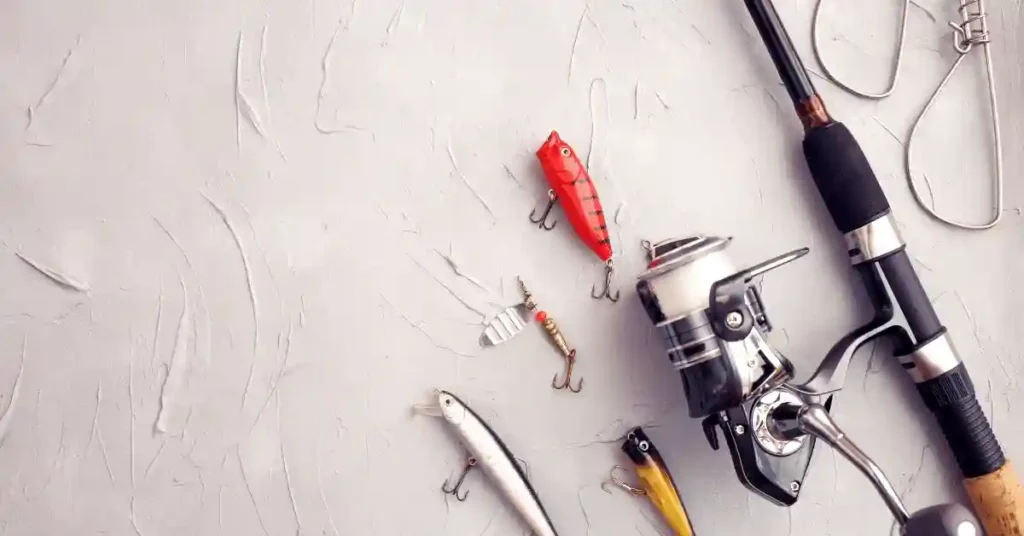
Now that we’ve covered the basics of medium and medium-heavy rods, let’s delve into some key factors to consider when choosing the right rod for your needs:
Target Species and Fishing Style
Think about the fish you want to catch and how you like to fish. If you’re going for smaller fish like panfish, trout, pike, walleye, or bass, a medium rod is a good choice.
It’s sensitive enough for finesse techniques but still strong for medium-sized fish. But if you’re after bigger fish like catfish, salmon, or large bass, go for a medium-heavy rod. It gives you the strength to handle these heavyweights.
And if you prefer techniques like baitcasting, flipping, or pitching a medium-heavy rod will give you the power you need.
Lure Weight and Casting Distance
Think about how heavy your fishing lures are. If you’re using lightweight lures between 1/8 to 1/2 ounce, go for a medium rod. It’ll help you cast accurately and control your lure well. Medium rods are also good for delicate fishing techniques and throwing small, light lures far.
But if your lures are heavier than 1/2 ounce, go for a medium-heavy rod. It’s stronger and will let you cast these heavier baits effectively. You might not cast as far, but the extra power of a medium-heavy rod makes handling bigger baits easy.
Fishing Conditions and Environment
Consider where you’ll be fishing. If it’s in spots with lots of stuff in the water, like branches or rocks, a medium rod’s flexibility is helpful. It’ll bend more and make it easier to deal with obstacles.
Medium rods are also gentler on your line when you’re reeling in a fish, which means less chance of it breaking.
But if you’re fishing in thick cover or deep water, a medium-heavy rod is better. It’s sturdy and can handle the extra weight. Plus, it gives you more control in tough fishing spots.
Personal Preference and Experience Level
Your tastes and how much you’ve fished before are also important when picking between a medium or medium heavy rod.
If you’re new or you like a rod that can handle lots of different fishing situations, go for a medium rod. It’s forgiving and flexible, which makes learning different fishing tricks easier.
But if you’re more experienced and want a specific rod for certain fishing styles or types of fish, a medium-heavy rod might be better. It’s stronger and can handle bigger lures, so you can tackle tougher fishing challenges.
Which Fishing Rod Power Is Ideal?
So, which fishing rod power is ideal for you? Well, it depends on your individual fishing needs. If you’re new to fishing or are targeting smaller species, a medium rod may be the way to go.
With a power rating of 6-12 pounds, it’s best suited for lures in the 1/8 to 3/4 ounce range and is good for freshwater or inshore saltwater.
The slower casting speed also gives you more control over your casts and the “give” in the rod makes it easier to catch smaller fish.
However, if you’re targeting larger species or are fishing in saltwater, a medium-heavy rod is likely your best option. With a power rating of 10-20 pounds, it’s designed to handle larger lures and fish, making it perfect for those big catches.
It has a faster casting speed and is stiffer and more sensitive, which makes it easier to set the hook and reel in bigger fish. A medium-heavy rod is best suited for lures in the 3/4 to 1 1/2 ounce range.
When making your decision, consider factors such as the size of the fish you’ll be targeting, the weight of the lures you’ll be using, and the type of water you’ll be fishing in. By doing so, you’ll be able to choose the best rod for your individual fishing needs.
Conclusion
In the end, whether a medium or medium heavy rod is better depends on what you need, what fish you’re after, and what you like. Medium rods give you flexibility and control, while medium heavy rods give you power and can handle bigger fish.
Think about your target fish, how you fish, how heavy your lures are, and how much experience you have in picking the right rod.
It’s also smart to try out different rods and get advice from people who’ve been fishing for a long time to find the perfect one for you.
So, whether you go for a medium rod because it’s versatile or a medium heavy rod because it’s powerful, enjoy figuring out which rod suits you best. Happy fishing!

Meet Ibrahim Khan, an avid angler and author in Fishing Teach. He shares his wealth of knowledge from his 16 years of experiences in fishing. His articles are a captivating blend of practical insights and thrilling tales that invite readers into the enchanting world of fishing.
Ibrahim’s guides are your go-to guide in the realm of fishing on this informational site. Hailing from a coastal paradise, Ibrahim’s passion for angling is the heartbeat of his life.

